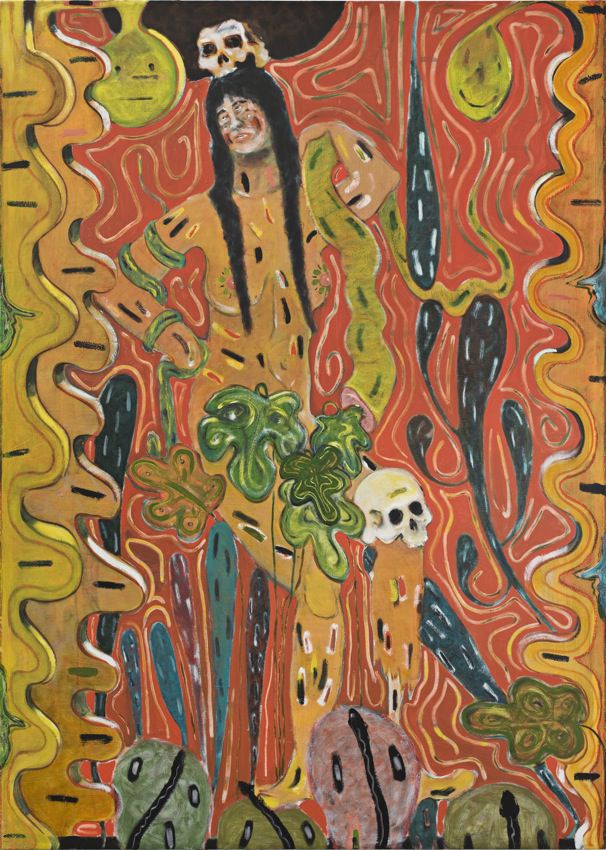For its 47th edition, Art Cologne put its ambitions front and center, ushering visitors off of the escalators and into a global art power zone bracketed by the booths of David Zwirner and Thaddeus Ropac. On one of the welcoming walls was Michael Riedel’s monumental photo of cardboard boxes bathed in an ultraviolet glow. The fresh-from-the-studio megalith faced Ropac’s electrified Jack Pierson affirmation: three letters that spelled YES.
It’s a word that Art Cologne director Daniel Hug is not afraid to say as he continues to tinker with the fair, which concluded Monday at the Cologne-Deutz Exhibition Centre. This year the Zurich-born American trimmed the fair by a day—pushing the preview to Thursday yet adding back a Monday that got lopped off years ago. This resulted in attracting a broad and increasingly international roster of 182 galleries (plus 23 in the second edition of the NADA fair-within-a-fair) that brought a Kirchner-to-Kusama mix of modern and contemporary art that was refreshingly low on hype and high on quality.
Yet, Hug hasn’t allowed the fair’s local character, or characters, to be lost. Walking around the blue-chip first floor, it was impossible to escape the work of Teutonic titans such as Gotthard Graubner, Raimund Girke, Imi Knoebel, and, above all, Joseph Beuys. From Munich came gray felt: a pair of floppy clipboards at Galerie Thomas and a saw-shaped swatch that hung rather menacingly overhead at Galerie Klüser. Heidelberg’s Edition Staeck stocked its booth with photos and small goods—a packet of sugar, a white enamelware bowl—scrawled with Beuys’ signature, while Ropac offered Versuch I, a 1980 photograph crossed out with intersecting red brushstrokes. At Galerie Hans Meyer, Beuys looked out from under his fedora in a 1972 portrait by Cologne native C.O. Paeffgen.
Painting dominated, but sculpture was a real crowd pleaser. Ropac brought Detain, one of Erwin Wurm’s luscious new mutilated bronze buildings, which found a pleasingly squishy-looking echo in Stephen Wilks’s large ceramic bottle at Amsterdam’s Galerie Paul Andriesse. Several galleries exhibited the work of Belgian artist Jan Fabre, who tiles objects in beetlewings so they appear colonized by iridescent barnacles. Guy Pieters Gallery showed a pair of Fabre’s polished bronze lambs wearing pointy hats and bow ties (make no mistake, these party animals have been to the Louvre) alongside a menagerie of taxidermy hybrids by Koen Vanmechelen. Galerie Scheffel’s fresh selection included two of Laura Ford’s “Bedtime Boy” sculptures, child-size figures standing calmly in pajamas with gray fabric elephant heads.
Also notable was the abundance of paper sculpture, including layered works by Oskar Holweck (at Galerie Utermann), Angela Glajcar (at Löhrl), and Beni Bischof, who sliced into issues of Vogue (at Galerie Rupert Pfab). Galerie Karsten Greve, which sprung for the fair’s largest booth and tiled the exterior in 13 large photos by Robert Polidori, devoted an entire corner of its prime real estate to the undulating cut paper works of Georgia Russell, whose De L’Imagination transformed a hardcover book into a shredded construction that suggested the headdress of a survivalist librarian.
Upstairs, younger galleries shined. Art Cologne newcomer Marlborough Contemporary dazzled with an assured oil by Koen van den Broek (another of the Belgian artist’s recent canvases impressed at Figge von Rosen) and one of the fair’s 22 “New Positions” single-artist showcases, devoted to the room-sized sculptural work of Lawrence Kavanagh. Standouts in the “New Contemporaries” section of 37 galleries founded since 2000 included Kadel Wilborn, which showcased the stunning painted photographs of Helen Feifel, and London’s Rokeby, dominated by a drawers-and-speakers assemblage work of “G-Plan furniture” by Michael Samuels. And after a long day on their feet, few fairgoers couldn’t resist pausing at the booth of Schleicher + Lange, where Krištof Kintera’s winged office chair suggested a collaboration between Staples and the Museum of Natural History.








